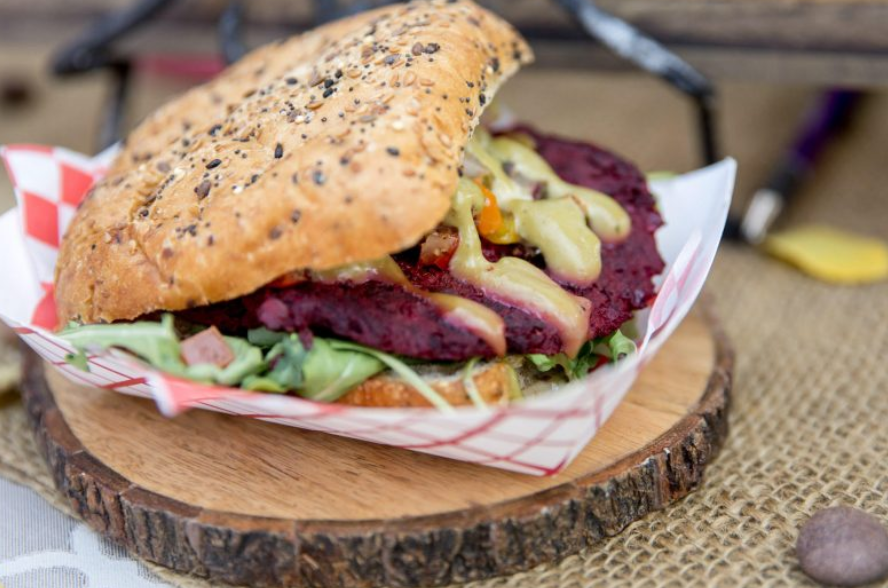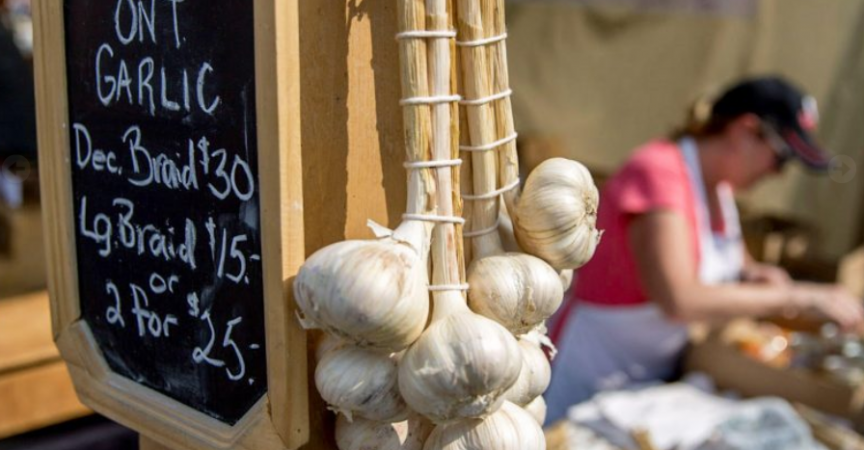This is Why Garlic Festivals Are So Special
When people express surprise at the idea of a festival devoted solely to garlic, my answer is that it’s not just any garlic. It’s domestically grown garlic! But the proof is in the pudding. And it’s the chefs serving savoury and sweet dishes at the Toronto Garlic Festival, and who give presentations and demos on how to prep and cook with it, and the farmers whose booths, festooned with garlic bulbs, garlic braids and powder, pickles, ferments and smoked and black garlic, who, together, shed light on the wonder of domestic garlic.
For Chef Matt Dunbar at No Small Feast, who’s at the Festival serving Atlantic Cod crispy fish tacos, roasted garlic and corn salsa, cabbage and lime slaw, and tequila tomatillo pesto, as well as a grilled cheese sandwich with bolognese and mozzarella, garnished with garlic boule, “it’s the fragrant, pungent flavour of local garlic that stands out. For a minimal price difference, there’s a great difference in taste. Local garlic has a softer, sweeter taste to it and has tertiary and secondary notes not found in imported garlic.”
Those tertiary and secondary notes Dunbar refers to have been well researched. Harvard-trained chemist Dr. Eric Block has been studying garlic for more than forty years. His book, Garlic and Other Alliums: The Lore and the Science, brings to life the complexity of allium chemistry. Dr. Block presented on “Garlic and Olfaction” at the 2012 Toronto Garlic Festival.

To illustrate what makes garlic tick, take, for example, the parts that make up nitroglycerin. Separately they’re inert and stable. But when mixed, they react violently. Something similar occurs in garlic when an invading pest or herbivore gnaws its way into the plant’s cell walls. That bite triggers a tripwire that activates the plant’s defence mechanism. Two substances stored separately in thousands of cells in the garlic plant are called into action. When the cell walls are breached by the invader, the enzyme alliinase and the compound alliin instantly react to form allicin. That chemical repels the invading pest, which can’t stand the odour. Allicin accounts for much of the smell and taste of garlic. While pests are repelled, we humans have adapted it into our cooking and medicine.
The amount of allicin created in preparation for cooking depends on the number of cell walls breached. And that depends on the method used, such as chopping, using a garlic press or other means. Most of the allicin is created in less than a second. However, additional reactions occur over minutes and hours. Each reaction begets a new chemical reaction. It’s these cascading chemical reactions that Dunbar is referring to when he talks about tertiary and secondary notes in garlic. He’s not imagining it, either. Because the chemical composition differs among garlic varieties, their individual tastes and odours also vary.
Along with the common claims, “we support local food… we love our farmers’ garlic,” there is a word offered by one chef — “vindication” — that speaks to garlic’s checkered past and why she appreciates garlic for more than its flavour.

Anne Sorrenti, Chef/Owner at Oakwood Hardware Food and Drink, has a reverence for garlic both as a food and from a social-historic perspective. For her, the Toronto Garlic Festival is a form of vindication. In describing the food of her childhood, influenced by her parents’ Italian-German roots, Sorrenti says, “we knew all along what was good. The rest of the world is catching up.” But there’s more to the story. Sorrenti’s parents, like many southern and eastern Europeans, and Asians, anyone not of Anglo descent, arrived in Canada in the early to mid-19th century in a vacuum. Two things they had in common were that they used garlic in their cuisine and they were marginalized in Canada. The fact that they all used garlic made garlic a way to classify them as ‘other.’ Hence, it was not uncommon, as Sorrenti says, to hear stories from her father of being referred to pejoratively as “garlic eater.” And that was one of the nicer things.
Sorrenti’s story of vindication started as a young girl cooking for a school friend.
While the Sorrentis had homemade tomato sauce, her friend ate Chef Boyardee. And while the Sorrentis ate pasta aglio e oglio, her friend had Stouffer’s Chicken Divan (a chicken broccoli casserole) with Minute Rice. And who was the embarrassed one? The family with the homemade tomato sauce or the family with the red, white and green labeled can of Chef Boyardee? Sorrenti explained:

My friend Veronique had store-bought canned food in her house, like Chef Boyardee. We couldn’t afford canned food. To me, homemade tomato sauce meant we were poor. Boyardee meant not poor. And the novelty of Boyardee, I really liked it when I first tasted it at Veronique’s house. Her mother served it with white wonder bread and margarine. It was good tasting as a novelty, but I knew then that it wasn’t good food. I wouldn’t have classified it as “Italian.” The real eye opener was when Veronique came over to my house one day after school and tasted my pasta. I was embarrassed at first, carrying cans of tomato sauce upstairs from the cantina. But she thought it was amazing. She had never tasted anything like it.
The Toronto Garlic Festival has been a blank slate for chefs like Dunbar and Sorrenti to explore the many possibilities, including the use of garlic in dessert. Over the years, the Festival has invited chocolatiers, ice cream, sorbet and gelato makers and pastry chefs to create new and interesting ways to combine garlic with desserts. Greatest hits include Brandon Olsen’s Coffee, Black Garlic and Passionfruit Truffle; Ron Raymer’s Roast Garlic Butter Tarts, Malty and Hoppy’s Black Garlic Beer Jelly; and Sorrenti’s Black Garlic and Beer Lollipops. Specialty ice cream flavours available only at the Festival have included Dark Chocolate & Roasted Garlic Ice Cream, Garlic Popcorn (by chocolatier Tim English), Laura Slack’s Black Garlic Dulce de Leche Ice Cream Pops and; Bourbon, Butterscotch & Black Garlic (Le Dolci). Black (fermented) garlic has a tar-like texture and a flavour reminiscent of licorice and tamarind. Featured coffees include Warm Garlic Infused Spiced Coffee with Maple Cream and Pumpkin Vanilla Dust from the Spice Chef’s Creations.
This year, Sorrenti made a special batch of Caramel Chocolate Chews based on a popular recipe from Sees Candy in California — the Sees Candy made famous in the Lucille Ball candy factory scene. Mary See, born Mary Wiseman in Ontario, was the family matriarch whose recipe started it all. Sorrenti’s twist on the Sees recipe: she added black garlic. For Chef Sorrenti, the road of vindication has been long travelled. While young garlic lovers experience the Festival from their perspective, for Sorrenti, there is another layer.
The nuanced possibilities of garlic grown in Canada are accessible not just for experienced chefs, but for home cooks, and Chef Jamie Kennedy, who will take time from selling his famous fries with garlic aioli at the Festival this Sunday to share his methods for eliciting garlic’s flavours. His talk, “50 Shades of Garlic”, takes place in the Ukrainian Credit Union Speakers’ Corner at 11:00 AM this Sunday, September 16 at the Toronto Garlic Festival. Sorrenti, in turn, will share “A HerStory of Garlic,” at 1:00 PM.
While the Toronto Garlic Festival celebrates the Ontario garlic harvest, garlic festivals across Canada celebrate their region’s harvest. Here is a link to others: https://www.torontogarlicfestival.ca/links/
Not only is the Toronto Garlic Festival a celebration of Ontario garlic, but it’s a celebration of virtually every culture and cuisine that uses garlic. It’s this, in turn, that makes the festival a window into Canadian culture and social history — because food is history.









